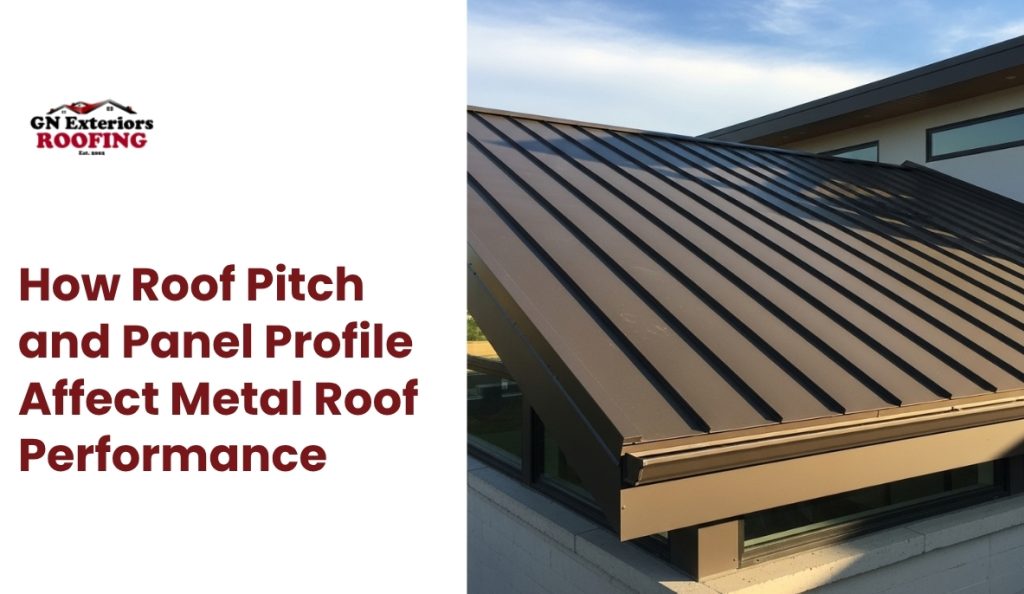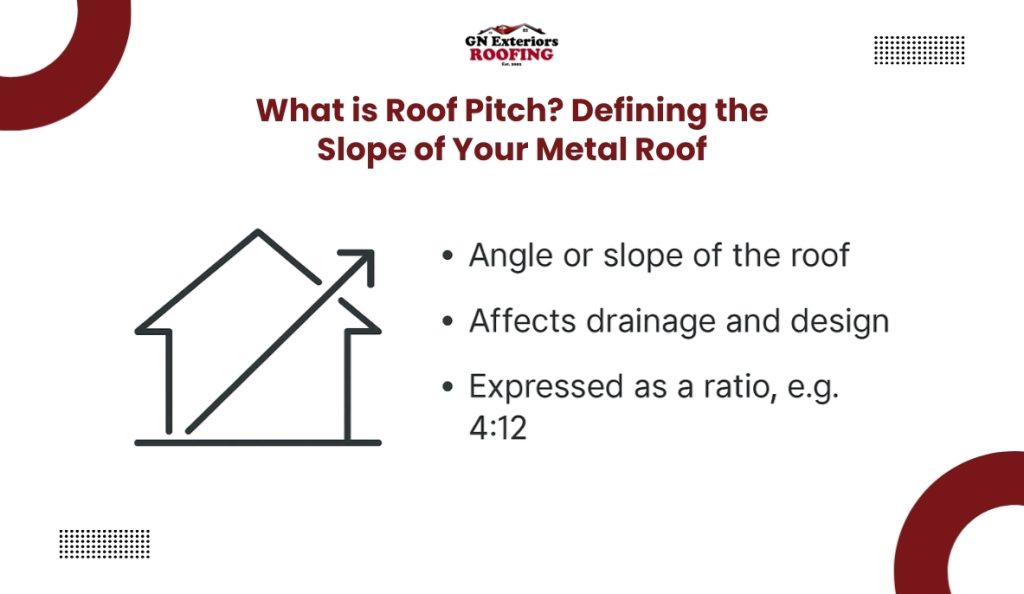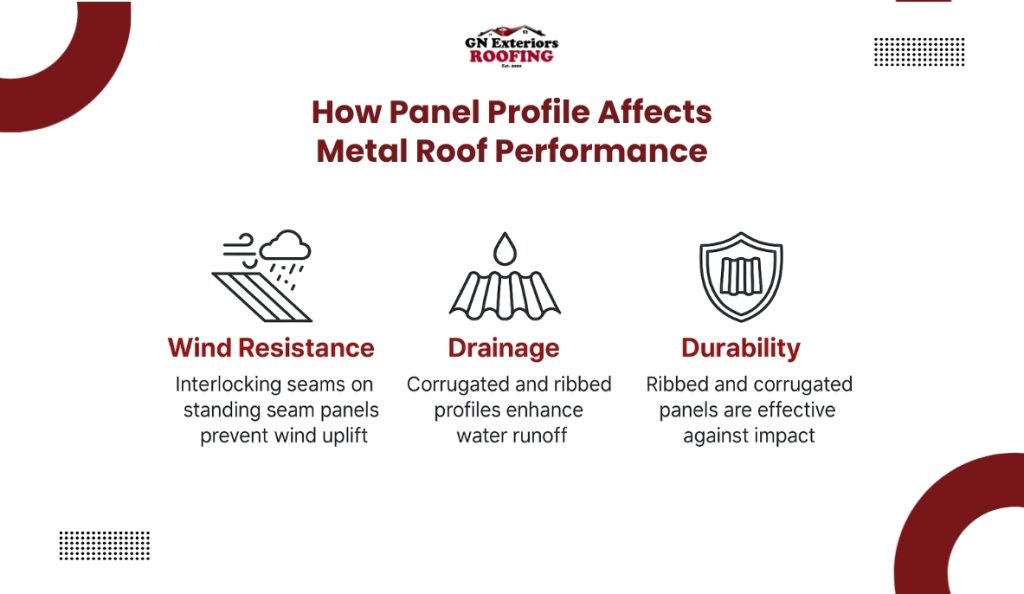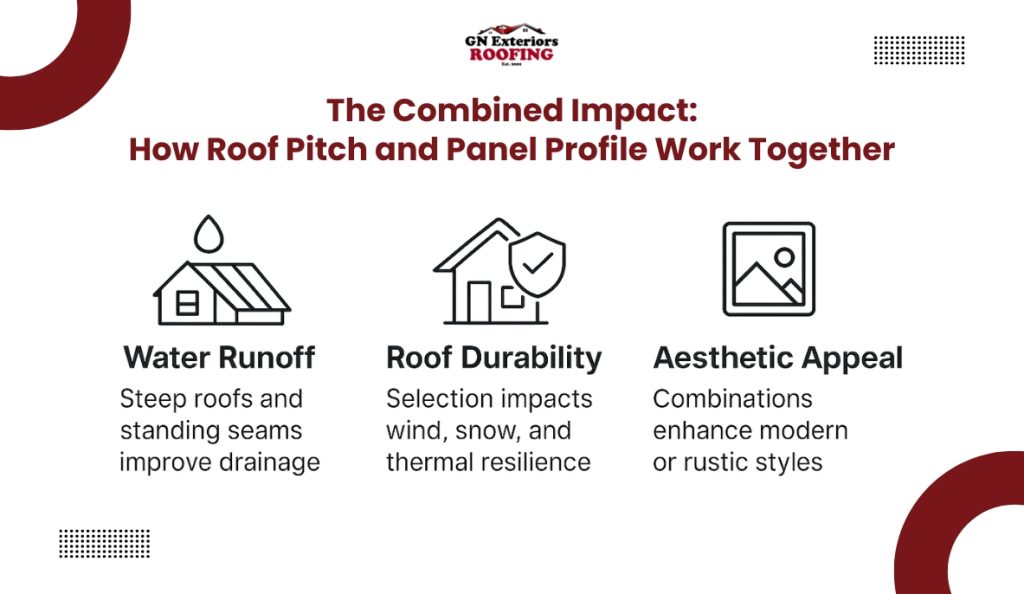
When considering a metal roof for your home or business, two key factors that significantly influence performance are roof pitch and panel profile. While these elements may seem like mere design choices, they have a direct impact on how well a roof performs in various conditions, affecting everything from water drainage to wind resistance and overall durability.
Roof pitch, the angle or slope of your roof, determines how water and snow are shed, which in turn affects the roof’s longevity and the maintenance required. On the other hand, the panel profile refers to the shape and structure of the metal roofing panels, each of which offers unique benefits in terms of aesthetic appeal, strength, and weather resilience.
In this article, we’ll break down the relationship between roof pitch and panel profile, exploring how each factor plays a role in optimizing the performance of your metal roof.

Roof pitch refers to the angle or slope of a roof, measured as the ratio of the vertical rise to the horizontal run. It is an essential aspect of roof design, influencing drainage, structural stability, and the overall aesthetic of the roof.
Pitch is typically expressed as a ratio, such as 4:12, meaning the roof rises 4 inches for every 12 inches of horizontal span. This measurement helps determine the roof’s angle and plays a key role in deciding the most suitable roofing materials and system.
Roof pitch impacts factors like drainage, airflow, and the potential for water pooling, making it an important consideration when selecting a metal roofing system.

Roof pitch has a direct impact on the overall performance of a metal roof, influencing factors such as water drainage, snow shedding, and resistance to environmental stresses.
The steeper the roof pitch, the more effective it is at shedding water, snow, and debris, which reduces the likelihood of buildup that can cause damage over time. This becomes especially important in areas with heavy rainfall or snowfall.
To ensure your metal roof performs optimally, it’s crucial to work with an experienced metal roofing contractor who can design the ideal pitch for your specific climate and roof type.
A proper roof pitch ensures that rainwater flows smoothly off the roof, preventing water from pooling and leading to potential leaks or structural issues. Similarly, snow is more likely to slide off a steep-pitched roof, reducing the risk of snow accumulation and the potential for ice dams.
In contrast, roofs with a lower pitch may require additional design considerations to ensure effective drainage and avoid water retention.
Beyond weather-related concerns, roof pitch also impacts the roof’s structural stability. A well-designed pitch helps distribute the weight of the roofing materials evenly, reducing stress on the building’s framework. This is particularly important for metal roofs, which are often chosen for their durability and ability to withstand extreme weather conditions.

Panel profile refers to the shape and structure of the metal roofing panels, which can vary widely depending on the design chosen for a building. These profiles are essential not only for the aesthetic appeal of the roof but also for its performance, durability, and suitability for specific environmental conditions.
There are several types of panel profiles, each offering distinct advantages. Common profiles include standing seam, corrugated, and ribbed panels, each of which provides different benefits in terms of water drainage, wind resistance, and overall structural integrity. The choice of profile can affect the roof’s ability to handle various weather conditions and its overall lifespan.
Standing seam panels are one of the most popular choices for metal roofs due to their sleek, modern appearance and excellent performance in harsh weather conditions. These panels feature raised seams that interlock to form a secure seal, preventing water infiltration.
Standing seam roofs are highly effective at shedding water, snow, and debris, making them ideal for high-end residential homes or commercial buildings with heavy rainfall or snow.
Corrugated panels are characterized by their wavy, repetitive pattern, which provides strength and flexibility. These panels are durable and resistant to high winds, making them an excellent choice for areas prone to severe weather.
The unique design of corrugated panels also allows for easy expansion and contraction, which helps prevent damage from thermal movement. These panels are best suited for agricultural buildings, sheds, and areas with moderate weather conditions.
Ribbed panels feature vertical ridges that provide additional strength and resistance to impact. They are often used in commercial and industrial settings due to their robustness and ease of installation.
Ribbed panels are often chosen for commercial or industrial roofs due to their strength, ease of installation, and ability to handle high-impact conditions. They are also effective in windy regions, offering structural stability.

The panel profile you choose for your metal roof has a significant impact on its performance, especially when it comes to factors like durability, weather resistance, water drainage, and overall strength. Each panel design offers distinct benefits depending on the specific needs of your roofing system.
The profile of the panels plays a key role in the roof’s ability to withstand high winds. For example, standing seam panels, with their interlocking seams, provide a tight seal that is less likely to be affected by strong gusts.
Corrugated and ribbed panels, due to their structural rigidity, are also known for their ability to resist wind uplift, making them suitable for areas prone to storms and high winds.
Wind resistance is essential for the long-term durability of your metal roof, particularly in coastal or storm-prone areas, where wind-driven rain or debris can cause significant damage to poorly secured roofs.
For regions with heavy rainfall, it’s important to prioritize water drainage. A steep-pitched roof combined with standing seam panels is ideal for effectively shedding water.
The standing seams, in particular, offer superior protection against leaks, as they are designed to prevent water infiltration through the seams. This configuration ensures that water flows off the roof quickly, reducing the chances of pooling or leaks.
In areas with moderate rainfall, corrugated or ribbed panels on a moderately pitched roof can provide sufficient drainage while offering a cost-effective option. However, it’s important to ensure that the panel profile selected facilitates water runoff and minimizes the risk of water retention.
Panel profiles contribute to the overall durability of the roof by enhancing its ability to withstand external forces such as impact, thermal expansion, and structural load. Standing seam panels, for instance, offer superior resistance to thermal movement and expansion, reducing the risk of leaks over time.
Ribbed and corrugated panels are highly durable, offering increased resistance to impacts and physical wear, making them ideal for high-traffic or industrial environments.
A durable metal roof with the right panel profile can handle harsh weather conditions, resist corrosion, and reduce the need for frequent maintenance or repairs, extending the lifespan of the roof.

Both roof pitch and panel profile independently affect the performance of a metal roof. However, when combined, they work together to enhance the roof’s overall functionality, aesthetics, and resilience. The right combination of pitch and panel profile is essential for maximizing drainage, wind resistance, and the roof’s ability to withstand the elements over time.
The synergy between roof pitch and panel profile plays a significant role in water runoff efficiency. A steep roof pitch combined with standing seam panels is highly effective at shedding water quickly, preventing the accumulation of rain or snow.
The raised seams on standing seam panels further enhance water resistance, ensuring that water flows smoothly off the roof without entering the seams.
In contrast, a lower-pitched roof with a corrugated panel profile might require additional design considerations to maintain proper drainage. Low-pitched roofs can struggle with water pooling, which may lead to leaks if the panel profile doesn’t allow for quick drainage. In these cases, ensuring that the panel profile complements the pitch is essential to avoid water-related issues.
Roof durability is enhanced when roof pitch and panel profile are selected with consideration for their combined effect on the roof’s exposure to environmental stresses. For example, a higher-pitched roof with ribbed or standing seam panels offers superior resistance to wind, snow, and thermal expansion.
When selecting a panel profile for a low-pitch roof, you must ensure the materials are robust enough to handle the strain of accumulated snow or rain. Corrugated panels, for instance, can provide additional strength and flexibility in low-pitched systems, ensuring durability over time.
Beyond performance, roof pitch and panel profile also contribute to the roof’s aesthetic value. A steep-pitched roof with sleek standing seam panels offers a modern, elegant look, often chosen for residential properties looking to achieve high-end appeal.
Meanwhile, corrugated or ribbed panels in combination with a low-pitched roof may give a more rustic or industrial appearance, which is often favored in commercial or agricultural buildings.
No matter which pitch and panel profile you choose, proper installation is crucial to achieving optimal performance. It’s essential to work with an experienced roofing contractor who understands the nuances of metal roofing systems.
Professional installation ensures that the roof pitch is accurately set, the panels are securely fastened, and the seams are properly sealed to prevent leaks.
When it comes to choosing the right roof pitch and panel profile, trust the experts at GN Exteriors. Our experienced contractors ensure your roof meets local building codes, adheres to weather resistance best practices, and accounts for factors like thermal expansion.
While it is possible to alter the pitch of a roof after installation, it is a complex and costly process. Modifying the pitch would typically require significant structural changes, including reinforcing the building’s framework. It’s best to select the right pitch from the outset to avoid unnecessary expenses later.
A properly pitched roof can influence your home’s energy efficiency by improving airflow and preventing heat buildup. Steeper roofs often allow for better ventilation, reducing heat accumulation during hot months, while also facilitating snow and water runoff in cooler climates. This can contribute to a more stable indoor temperature, potentially lowering heating and cooling costs.
For homes in hurricane-prone areas, standing seam panels are often the best choice. Their interlocking design provides superior wind resistance, helping prevent panels from being uplifted during extreme winds. Ribbed panels can also offer good performance in high winds, but standing seam panels provide the most secure and weather-resistant option for such conditions.
The color of a metal roof can influence its heat absorption and energy efficiency. Lighter-colored roofs reflect sunlight, helping keep homes cooler in warmer climates, while darker-colored roofs absorb heat, providing better insulation in colder climates.
The pitch of the roof does not directly affect the color’s performance, but a steeper pitch may facilitate better airflow, helping to regulate the temperature inside.
Yes, there are eco-friendly metal roofing options, especially with standing seam and corrugated profiles. Many metal roofing panels are made from recycled materials and can be fully recycled at the end of their lifespan. Additionally, reflective coatings can be applied to improve energy efficiency, reduce heat island effects, and contribute to sustainable building practices.
The cost of a metal roof can vary depending on the pitch and panel profile selected. Steeper roofs may require more materials and labor for installation, increasing the overall cost. Similarly, standing seam panels tend to be more expensive due to their high durability and sleek aesthetic, while corrugated or ribbed panels may be more affordable.
However, investing in the right combination of pitch and profile can reduce maintenance costs and increase the roof’s lifespan.
Yes, metal roofing can be installed on a flat roof, but a slight pitch (typically a 1:12 slope or greater) is recommended to ensure proper water drainage. While it’s called a “flat” roof, even low-slope roofs need to have a minimal pitch to prevent water from pooling and causing damage over time.
The choice of panel profile can affect the roof’s insulation requirements. Panels with a more pronounced profile, such as standing seam or ribbed, may offer some insulation benefits due to their air pockets, improving thermal efficiency.
However, additional insulation may still be necessary depending on your region’s climate and the type of building. Proper insulation helps ensure optimal comfort and energy savings.